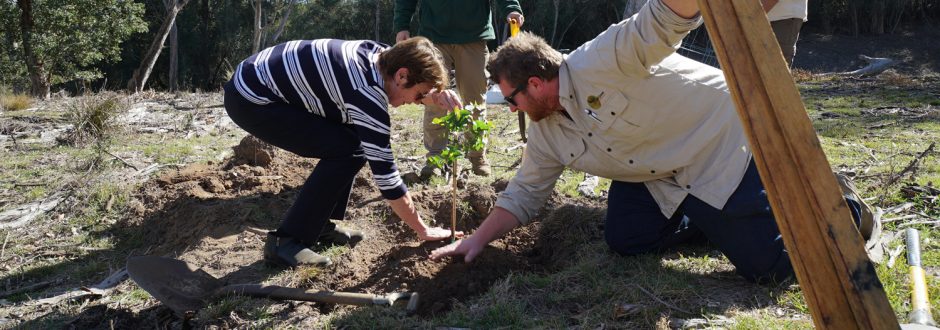Three seedlings of the endangered Camden White Gum have been planted in their natural habitat on the banks of the Nepean River in the latest initiative by the Sisters of the Good Samaritan to restore the ecosystem of their Mater Dei property in New South Wales.
The property, which adjoins the Nepean River at Camden, contains substantial tracts of the Cumberland Plain Woodland, which is listed in NSW and Commonwealth legislation as “an endangered ecological community”.
The tree planting, which took place on July 31 just after National Tree Day (July 29), was the culmination of three years’ work to save the threatened river gum species.
Congregational Leader Sister Patty Fawkner was among the small group gathered for the informal ceremony.
“It was very simple in one way, but actually it was hugely significant,” she said.
Patty said that with the planet under such stress and the country in the grip of drought, the planting of the endangered seedlings was an important step in trying to ensure more biodiversity.
“These Camden White Gums, they’re quite endangered, and we planted three of them,” she said.
“They only grow in small sections along the Nepean and our property is one of them. So this has been a long while getting the saplings to this stage. We’re hoping they will flourish here.”
The saplings were planted on the section of the Mater Dei property designated as the Sisters of the Good Samaritan Wivenhoe Conservation Project.
In 2012, the Sisters entered into a contract with the NSW Government’s Office of Environment and Heritage (OEH) to set aside a piece of land on their 260 hectare property, for ecological restoration.
The site has two BioBanks, of about 100 hectares in total, where the OEH provides funds for the gradual restoration of the land. Each year, agreed outcomes, including the removal of feral animals and weeds and regeneration of native species, must be achieved, so that money can be released for further work.
Brendon Levot, from Toolijooa Environmental Restoration, the company contracted by the Sisters to carry out the restoration work on the property, said the process of collecting the seeds of the Camden White Gum (Eucalyptus benthamii) and bringing them to sapling stage for planting took three years, the granting of a special license from the State Government, and painstaking work.
The seeds were taken from four mature Camden White Gums on the property, which are somewhere between 50 and 150 years old, with a lifespan up to 300 or 400 years.
One of the reasons this species of gum is endangered is because it only germinates in times of flood and there are now fewer of the trees located along the alluvial floodplain of the Nepean.
A team of experts from Toolijooa gathered the seeds from the Camden White Gums on the property and carefully propagated them until three of the saplings were ready to plant.
“They have a really low strike rate,” Brendon said. “So… we probably collected quite a few hundred seeds, only nine of those seeds sprouted, and of that nine, only five survived.”
Brendon said that with careful watering in the early stages and “some TLC”, he’s hopeful the saplings will grow into mature trees.
“Well, Sister Patty did bless them,” he laughed. “So, I’d say the chances are pretty good if you ask the big fella!
“Yeah, but realistically, we’ll just keep the watering up to them, so that they do survive.”
Of the five seedlings germinated from existing gums on the property, three have been planted and two remain in the nursery. Twelve other seedlings, germinated from trees outside the property will also be planted on the Good Sams’ BioBank.
Brendon, who has been working on the Wivenhoe Conservation Project for some years, said the planting of the gums was a significant personal milestone.
“Knowing that my children will grow up to see the Camden White Gum,” he said. “You know, that’s why we do this.
“Conservation is such a drawn-out thing. Half of what I do in my career, I’ll never reap the rewards of. It’ll be for the future generations. So I think that’s quite significant, to be a part of something bigger.”
Patty said the planting was also an important step in the long-term ecological commitment of the Good Samaritan Sisters, as expressed in their Statement of Directions from the 2017 Chapter.
“We talk about our commitment to ecological conversion and that operates on many layers – a spirituality level, a theological level, the practical level of trying to convert this tract of land, to remediate it and just give it the best chance possible of flourishing,” she said.
“It’s right there with our commitment to the environment and the whole broader cosmos really.
“The planting of these endangered species saplings is a little thing, but it operates on all sorts of levels: from caring for that local patch of land on the Mater Dei property, to encouraging more diverse species. That, we believe, contributes to the whole well-being of the planet and beyond.”
